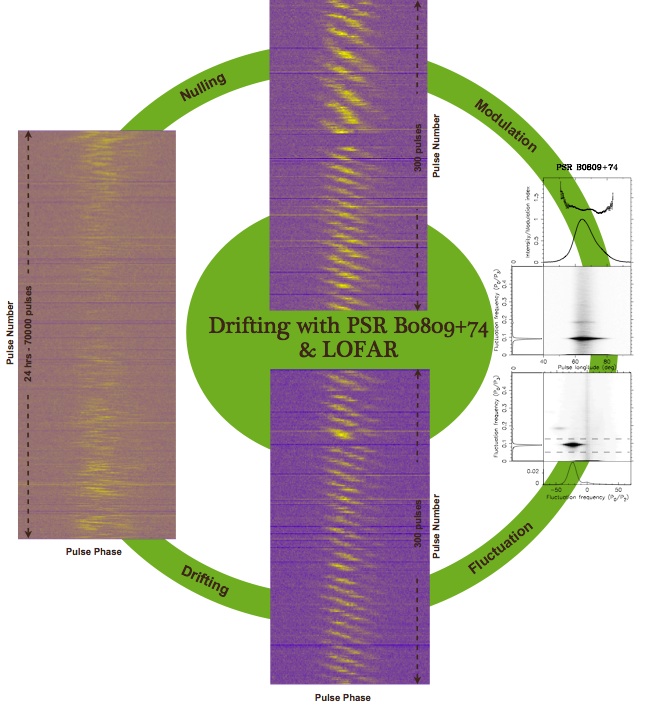Daily Image
30-10-2009Drifting with LOFAR
| Submitter: | Ben Stappers |
| Description: | At the end of Pulsar Busy Week 4 (PBW4) we took another 64-hour-long HBA observation of PSR B0809+74 to check, amongst other things, how things had improved since PBW2, when we made a similar observation using only 4 HBA tiles (see Daily Image 13-03-2009). Here we recorded the data from three full stations simultaneously. The stations were recorded separately so as to allow us to compare the sensitivities and beam shapes of the three stations (see LOFAR Status Meeting of 14-10-2009 for more information). We also took the data from the three sations and combined them incoherently offline to study the single pulses of the pulsar. A total of almost 200,000 pulses were observed The above plot shows the brightest 70,000 pulses, which were recorded in the last 24 hours when the pulsar was much brighter because of scintillation. In the left panel we see a pulse stack (pulse longitude, zoomed in on the pulse, versus pulse number) of all the single pulses with the "greyscale" indicating the intensity. The decrease in intensity is due to the decrease in sensitivity as this circumpolar source gets closer to the horizon. The lower middle plot shows how the first 300 pulses demonstrate the drifting phenomenon, where the subpulses which add up to form the average pulse profile, appear to arrive at earlier pulse longitudes. The upper panel shows a series of pulses where the drifting is interrupted by a series of nulls, where the pulsations stop completely. After the null one can see that the slope of the drift bands changes and subpulses appear broader. This phenomenon was seen in the paper by van Leeuwen et al. 2002 and tells us a lot about the emission from this pulsar. The right-most plots show the so-called 2dfs (see Weltevrede, Stappers and Edwards 2007) which reveals the "clarity" of the drifting with the extreme regular nature over large numbers of pulses resulting in the first three harmonics of the drifiting being detected, something that is almost unprecedented. These data highlight the rich rewards, both commissioning and scientific, that even these early data-sets provide. Once the full complement of LOFAR stations is in place it will allow us to study the single pulse properties of a large fraction of all pulsars with unprecedented sensitivity. |
| Copyright: | Hassall, Stappers and Pulsar Working Group |
| Tweet |  |
